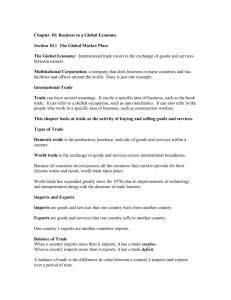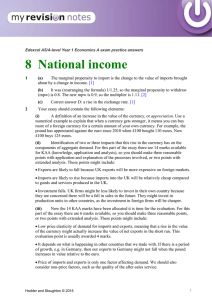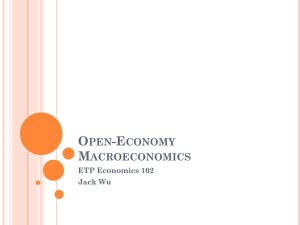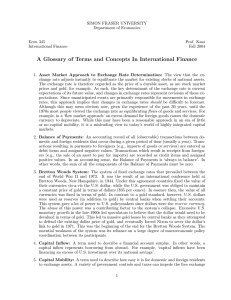Unit 2.01 PowerPoint
advertisement
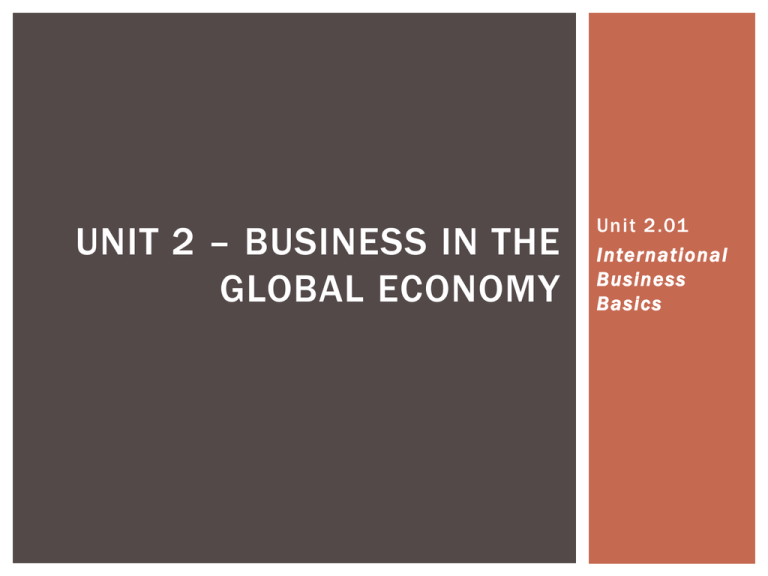
UNIT 2 – BUSINESS IN THE GLOBAL ECONOMY Unit 2.01 International Business Basics KEY TERMS Imports Exports Balance of Trade Balance of Payments Exchange Rate IMPORTS items bought from other countries US #1 importer in the world In 2014, the US imported $2.41 Trillion Top US imports: 1. 2. 3. 4. 5. Oil Machines, engines, pumps Electronic equipment Vehicles Medical, technical equipment Note: US imports ALL our bananas, coffee, cocoa, spices, tea, silk, and crude rubber EXPORTS goods and services made in the US that are sold to other countries US 2 nd largest exporter in the world (behind China) In 2014, the US exported $1.623 Trillion T op US Exports 1. 2. 3. 4. 5. Machines, engines Electronic equipment Oil Vehicles Aircraft, spacecraft BALANCE OF TRADE Difference between a country’s total exports and total imports Trade Surplus Export (sells) more than it imports (buys) Favorable balance of trade Trade Deficit Imports (buys) more than it exports (sells) Unfavorable balance of trade US BALANCE OF TRADE Current U.S. Trade Deficit - $41.8 Billion TOP 15 US TRADE PARTNERS U.S. TOP TRADING PARTNERS Rank 1 2 3 4 5 6 7 8 9 10 Country World European Union Canada China Mexico Japan Germany South Korea United Kingdom France Brazil Taiwan Exports Imports 1,620,532 276,142 312,421 123,676 240,249 66,827 49,363 44,471 53,823 31,301 42,429 26,670 2,347,685 418,201 347,798 466,754 294,074 134,004 123,260 69,518 54,392 46,874 30,537 40,581 Total Trade Trade Balance 3,968,217 694,343 660,219 590,430 534,323 200,831 172,623 113,989 108,215 78,175 72,966 67,251 -727,153 -142,059 -35,377 -343,078 -53,825 -67,177 -73,897 -25,047 -569 -15,573 11,892 -13,911 BALANCE OF PAYMENT Difference between the amount of money that comes in to a country and the amount of money that goes out Positive – when more money coming in to a country than going out Negative – when more money going out of a country than coming in TRADING AMONG NATIONS Absolute Advantage – exists when a country can produce a good or service at a lower cost than other countries Typically results from an abundance of natural resources or raw materials i.e. coffee in South America or oil in Saudi Arabia TRADING AMONG NATIONS Comparative Advantage – situation in which a country specializes in the production of a good or service at which it is relatively more efficient i.e. a country produces both computers & clothing better than any other country; but the market for computers is stronger/more profitable; so country decides to invest in computer production and buy clothing elsewhere INTERNATIONAL CURRENCY Foreign exchange rates – the value of a currency in one country compared with the value in another Effects imports/exports Example: If the Toyota Motor Company can produce a car for export in Japan at a cost of 2,000,000 Yen, how much does that car cost in U.S. dollars? If the exchange rate for Yen/U.S. Dollar is 200.00 yen to the dollar, the car would have to cost $10,000 at the factory for the Toyota company to realize its costs. Toyota cars typically sell for $20,000+ US dollars, making the car very profitable to export to the US (for Japan) As Yen/US Dollar exchange rates change to 100.00, it now costs $20,000 at the factory to make, therefore reducing the Japanese profit and lowering the incentive to export to the US INTERNATIONAL CURRENCY Factors af fecting currency values Balance of payments – when favorable, stronger currency Economic conditions – when buying power of currency declines (i.e. high inflation), value of currency declines Political disability – country instability weakens currency RECENT VALUES OF CURRENCIES Source: http://www.xe.com/ ASSIGNMENT Calculate the cost of the following 5 items in local currency: Item US$ Pack of gum $1.00 Pair of jeans $50.00 iPad2 $500.00 Ford Focus $15,000 New home $300,000



